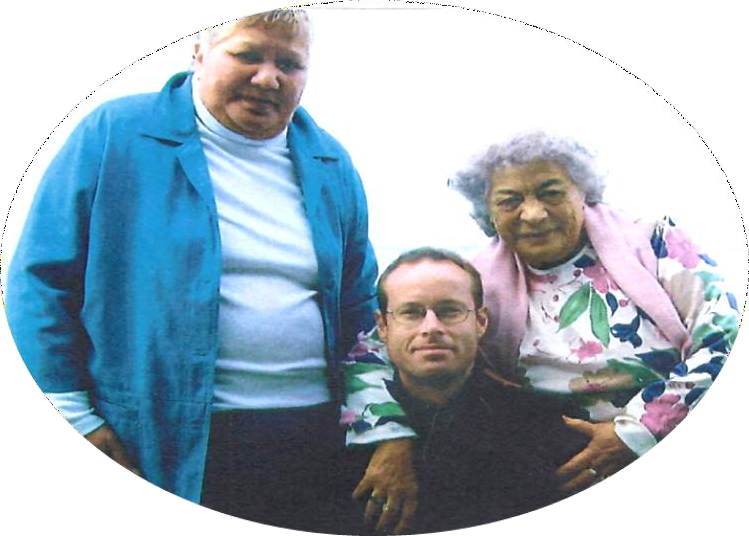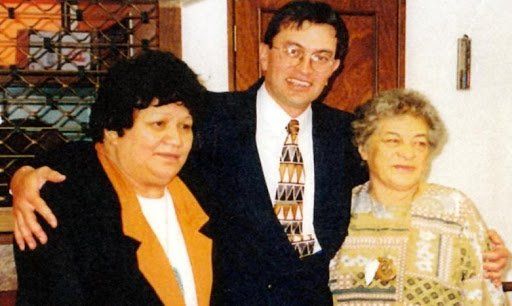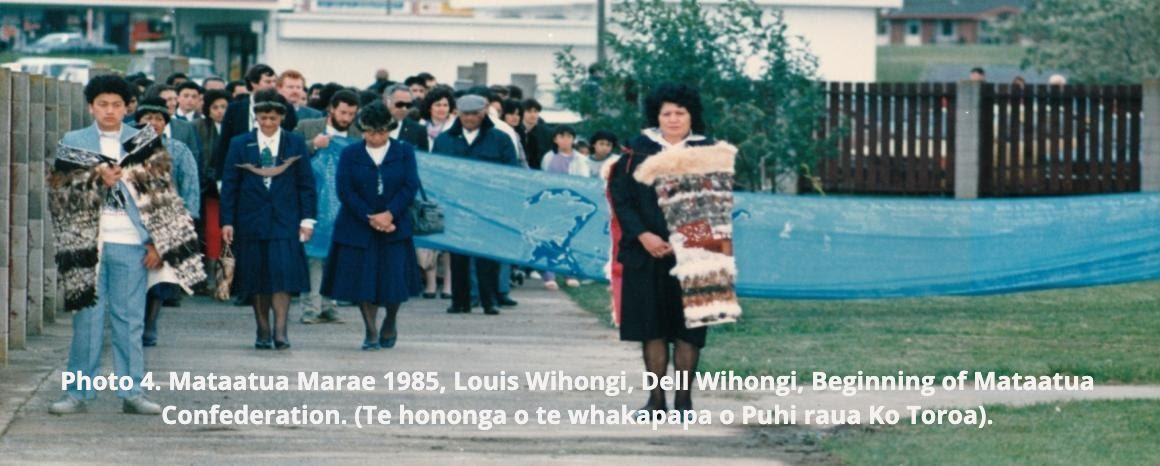Introduction
Photo 2. Dell Wihongi, Leo Watson (Taitokerau counsel), and Saana Waitai-Murray, Te Hāpua 2006
The Native Flora and Fauna Claim, WAI 262, had its origins in the ideals and visions of a group of land rights activists of the 1970s and before – Saana Waitai-Murray (Ngāti Kurī), Dell Wihongi (Te Rarawa), John Hippolite (Ngāti Kōata), Tama Poata (Te-Whanau-o-Ruataupare), and Witi McMath (Ngāti Wai).
Acting as individuals, and with the assistance of lawyer Moana Jackson (Ngāti Kahungunu), they lodged the Native Flora and Fauna Claim – WAI 262 in October 1991. Of these, the two women of the Far North, Saana Waitai-Murray of Te Hāpua, Te Rerenga Wairua, and Dell Wihongi of Otarihau, Hokianga, were to become the unshakeable champions for the claim.
For many years Saana had challenged the actions of the Crown in depriving her people of access to their lands and coastlines. Besides the loss of ancestral land, the denial of access to the native plant and animal life threatened the survival of the skills and knowledge of the traditional arts and crafts and medicinal remedies based on those species.
Photo 3. Dell Wihongi, Maui Solomon (Taitokerau counsel) &
Saana Waitai-Murray Waitangi Tribunal Hearing Rotorua 1998
The story of Saana’s personal and inspirational crusade to retain and regain the ancestral lands of Ngāti Kuri can be found in Te Karanga o te Kotuku, published by her long-time friend Tama Poata, for the Māori Organization On Human Rights, in 1974.
Te Karanga o te Kotuku documented, through her correspondence, Saana’s struggle to have the issues she raised acknowledged by the Crown, by the authorities and, at times, by her own people. The publication of this work helped to raise awareness about – and to provide documented evidence for - the genuine issues Māori faced, and also the difficulty they had in the late 1960s and early 1970s in having these issues heard and considered. The book provided a major impetus for the 1975 Māori Land March, and one of the reasons that the Land March began in the Far North. The core subject-matter of the book eventually proved to be one of the bases for the development of the WAI 262 claim.
Dell Wihongi drew her impetus and vision from the tōhunga Toki Pangari who held one of the last whare wānanga at Utakura on 26 November 1949. Toki was Del’ls grandfather, and he passed down a considerable body of mātauranga to Dell who lived with him as a child – she later received his extensive writings from her uncle Joe Toki, and re-recorded them. These writings are significant to the claim in that the connection to Kupe and Nuku is established and represented in the tāonga or maaka left by this great navigator.
Dell was of the view that each iwi has their own version of the Kupe kōrero, and as such she viewed the claim as belonging to ngā iwi katoa. Dell believed that the restoration of rangatiratanga, kaitiakitanga, mātauranga Māori and traditional knowledge is imperative to ensure future generations will continue to benefit from the wisdom passed down from former generations.
Mid-1970s
The Auckland Committee on Racism and Discrimination (ACORD), including Oliver Sutherland, established a relationship with Saana Waitai-Murray, her whanau and the people of Te Hāpua, supporting Saana’s efforts to retain ancestral Ngāti Kurī land at Te Hāpua and Kapowairua. Saana’s injunction, lodged in 1975, supported by kaumātua Herewini and Neta Paraone, to prevent a cross-lease with the Crown, led to the shareholders of the Te Hāpua 42 Incorporation finally rejecting the Crown’s efforts to alienate ancestral lands – Murimotu and Muriwhenua.
Carmen Kirkwood of the Huakina Trust wrote to the Department of Scientific and Industrial Research (DSIR) saying ‘it’s not just finance stopping my people returning to their homes, it’s knowledge of what they can do with their lands’. Saana’s whānau who were re-occupying their land at Te Hāpua/Kapowairua, also wanted to explore options for land use other than the pine plantations of the Northern Pulp Company.
Entomology and Plant Diseases Divisions of DSIR assisted the Department of Māori Affairs Marae Enterprise Scheme by establishing experimental gardens at Te Hāpua. Under the leadership of Herewini and Neta Paraone and the guardianship of Saana Waitai-Murray, her brother Ross & Lucy Norman and Dave & Josephine Neho, trials of pineapples, peanuts, and of other horticultural crops were undertaken at Te Hāpua and Kapowairua (Spirits Bay).
‘Te Hāpua Traditional Arts and Crafts Trust’ weavers’ collective was established at Te Hāpua.
Sales of kete, whāriki, piupiu and poi in Auckland and elsewhere encouraged the retention of traditional knowledge and skills, conservation of the associated plants and provided stable, ongoing income for the women of Te Hāpua and neighbouring communities for many years. But Crown restrictions (if not outright prohibitions) on the harvesting of pīngao, kiekie, hoihere, raupō and kākaho from lands in the Far North were a continuing impediment to the weavers.
John Hippolite (Ngāti Kōata) accompanied ACORD on visits to Te Hāpua and Kapowairua and so established his links with Saana and Ross and Lucy Norman and their whanau. He stayed with them in one of the traditional raupō whare constructed by Saana which she hoped would one day house an ‘Out Post School’ for the young people of Ōtara she was teaching at Hillary College. Like Saana, John was a long-time land rights activist, and was particularly concerned over the actions of the Crown over its acquisition of Takapourewa (Stephens Island) by the Crown as a reserve for tuatara and for the Crown’s assumption of the right to manage the species.
In the mid-1980s Dell was one of the four women known as ‘Ngā Hau e Whā’, who worked to restore relationships with descendants from the Mataatua waka, known as the Mataatua Confederation. She was also Chairwoman for the Confederation of Chiefs, who were entrusted with upholding the mana of He Whakaputanga, the Declaration of Independence, 1835.
Meanwhile, Witi, Tama, Saana and John were all active participants in the 1975 Land March, led by Whina Cooper, and in the fight for Māori land rights which led up to it.

The claimants vision and aspiration seeks to restore “te tino rangatiratanga o te Iwi Māori in respect of flora and fauna and all of our taonga.” Taonga being those things and values which we treasure, material, non-material, tangible and intangible.
Contact Us
Tēna koe, Tēnā koutou
Thank you for signing up to our e-panui for Wai 262 we look forward to keeping you connected to updates and helpful information as we continue the kōrero with community.
If you have any pātai please email
projects@wai262.nz
Please try again later.
Contact Us
Mailing address:
Attn Walter Wells
5399 Far North Road,
Ngataki, RD4, Kaitaia 048
All Rights Reserved | Wai262
Curated by MEA | Website by AWA Digital



